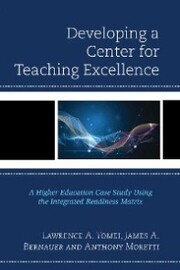Detailansicht
Developing a Center for Teaching Excellence
eBook - A Higher Education Case Study Using the Integrated Readiness Matrix
ISBN/EAN: 9781475826135
Umbreit-Nr.: 2184709
Sprache:
Englisch
Umfang: 168 S.
Format in cm:
Einband:
Keine Angabe
Erschienen am 23.09.2016
Auflage: 1/2016
E-Book
Format: EPUB
DRM: Adobe DRM
- Zusatztext
- <span><span>Developing a Center for Teaching Excellence: A Case Study Using the Integrated Readiness Matrix</span><span> builds on the 2015 text,</span><span>Integrating Pedagogy and Technology: Improving Teaching and Learning in Higher Education</span><span> with a focus on teaching in higher education.</span></span><br><br><span><span>Developing a Center for Teaching Excellence</span><span> is premised on our contention in the first book that, while individual faculty members can independently begin to use the IRM to improve their pedagogical and technological skills in their content areas, an organizational structure is needed to sustain ongoing improvement. In addition, while the first book provided a primer on learning theory as it relates to pedagogy,</span><span>Developing a Center for Teaching Excellence</span><span> plumbs this topic more deeply from the perspective of the college instructor. Further, the second book is dedicated to demonstrating how the IRM can be institutionalized as the foundation for providing the structure and support to faculty and how they can help shape centers for teaching excellence by becoming more familiar with relevant learning theories and related pedagogical and technological approaches.</span></span>
- Kurztext
- <span><span>Developing a Center for Teaching Excellence: A Case Study Using the Integrated Readiness Matrix</span><span> builds on the 2015 text, </span><span>Integrating Pedagogy and Technology: Improving Teaching and Learning in Higher Education</span><span> with a focus on teaching in higher education.</span></span> <span><span>Developing a Center for Teaching Excellence</span><span> is premised on our contention in the first book that, while individual faculty members can independently begin to use the IRM to improve their pedagogical and technological skills in their content areas, an organizational structure is needed to sustain ongoing improvement. In addition, while the first book provided a primer on learning theory as it relates to pedagogy, </span><span>Developing a Center for Teaching Excellence</span><span> plumbs this topic more deeply from the perspective of the college instructor. Further, the second book is dedicated to demonstrating how the IRM can be institutionalized as the foundation for providing the structure and support to faculty and how they can help shape centers for teaching excellence by becoming more familiar with relevant learning theories and related pedagogical and technological approaches.</span></span>
- Autorenportrait
- <span><span>Lawrence Tomei</span><span>is the Vice Provost for Academic Affairs and a Professor of Education at Robert Morris University in Pittsburgh, PA. Dr. Tomei has published numerous articles and books on instructional technology and education and is editor-in-chief of the International Journal of Information and Communication Technology Education. He is a US Air Force veteran and retired as a lieutenant colonel.</span></span><br><br><span><span>Jim Bernauer</span><span>is an Associate Professor in the School of Education and Social Sciences at Robert Morris University in Pittsburgh, PA. His major interests are learning and teaching in Pre-12 and higher education and research methodology.</span></span><br><span></span><br><span><span>Anthony Moretti</span><span>is the Director of the Center for Innovative Teaching and Directed Engaged Learning at Robert Morris University, where he also is an Associate Professor in the School of Communications and Information Systems. He earned his PhD from the E. W. Scripps School of Journalism at Ohio University.</span><span></span></span>
